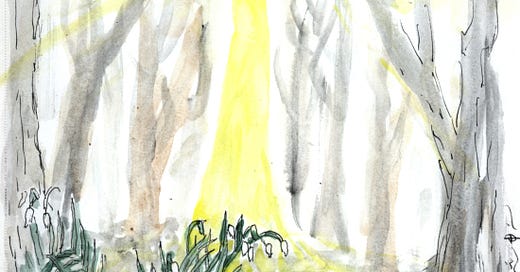Snowdrops herald new beginnings, hope, and purification, and are one of the first flowers to bloom in the year. In Catholic tradition, they are a flower of the Blessed Virgin Mary and embody the mystery of Candlemas (Feb. 2). Candlemas commemorates both the Presentation of Jesus at the Temple forty days after his birth, and the Purification of Our Lady Mary herself at that time in fulfillment of the Law of Moses. It is one of the oldest feast days of the church, recorded as having been celebrated in Jerusalem in the 380s.
We are far past Candlemas, and in fact, in Catholic tradition, we are now celebrating the Octave (Eight Days) of Easter! While a last Snowdrop or two bloom in the forest, newness has given way to other celebration — plant and forest life express new life in full, as do we in our hearts, minds, bodies, and spirit at this time of year.
Although Snowdrops in flower are a tale that the awakening of spring usually tells, I offer this illustration as my first Easter “Hello!” to you. Or, in the language of the Paschal greeting (Easter Acclamation): “Christ is Risen!”
I just learned that the traditional response to this greeting is: "Indeed He is Risen!" or "He is Risen indeed!" And you might conclude with, “Alleluia!”
Snowdrops in Adoration
Never having done so previously, I began attending Daily Mass a year ago last spring. There, I discovered expressions of devotion brand new to me. Including this one:
Once a week on our Island, Eucharistic Exposition and Adoration follows the Mass. That is, the consecrated host — a circular piece of unleavened bread — is placed in a monstrance, a sunburst-like receptacle, and displayed for a period of time. The faithful engage in quiet contemplation and prayer related to Christ’s mystery and sacrifice, and in reverence of his actual presence there before us. Some monstrances can be quite ornate. Ours is of a simple form, resembling rays of light.
For those who love words, here’s the etymology of this unusual word, monstrance:
Middle English mustraunce, monstrans demonstration, monstrance, from Anglo-French mustrance show, sign, from Medieval Latin monstrantia, from Latin monstrare to show, from monstrum
(Thank you, Merriam-Webster.)
Not long after I began engaging in this kind of worship, I began to experience the Holy Eucharist in nature - such as when I woke one winter night to the Full Moon streaming through my window, or sometimes when I come upon the Sun in brilliance between the trees.
In the above illustration Snowdrops engage in an adoration of their own.
Thank you, dear Reader, for opening The Book of Deer!
Next missive arrives Friday, April 14.





